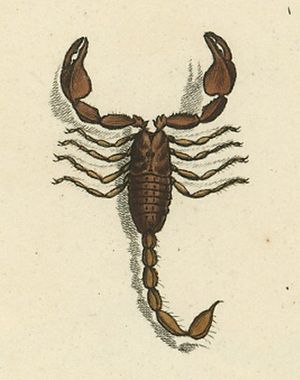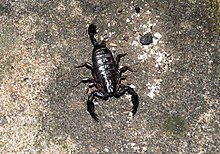Euscorpius germanus
| Euscorpius germanus | ||||||||||||
|---|---|---|---|---|---|---|---|---|---|---|---|---|

Euscorpius germanus |
||||||||||||
| Systematics | ||||||||||||
|
||||||||||||
| Scientific name | ||||||||||||
| Euscorpius germanus | ||||||||||||
| ( CL Koch , 1837) |
Euscorpius germanus (also German scorpion or Alpine scorpion ) is a species of scorpion fromthe Euscorpiidae family . The relatively small distribution area of the very small species with a length of less than 30 mm is limited to the eastern Alps . Despite the specific epithet , this scorpion does not occur in Germany.
features
With a length of less than 30 mm, E. germanus is one of the smallest species in the genus Euscorpius . Swiss males had an average length of 23.5 mm, the slightly larger females reached an average of 25.7 mm. The animals are generally dark brown, sometimes blackish, and the belly, legs and telson are clearly lighter.
E. germanus differs from the other species of the genus by the lack of keels in the segments of the mesosoma and mostly by five trichobothria on the underside of the pedipalpenhand (Chela manus). The morphological differences between E. germanus and the very closely related species Euscorpius alpha are very small, E. alpha normally has 6 trichobothria on the underside of the pedipalp hand.
distribution and habitat
The relatively small distribution area is limited to the eastern Alps . In Switzerland, the species occurs only in the extreme east in the Münstertal , in Italy mainly east of the Adige in the regions of Trentino-South Tyrol and Friuli-Venezia Giulia , in Austria in western North Tyrol , in the Kaiser Mountains , in East Tyrol and in western Carinthia and in Slovenia in the Julian Alps .
In Switzerland, E. germanus predominantly inhabits rock rubble and scree, poor grasslands in high areas and larch forests at altitudes of up to 2250 m. In Austria the species inhabits comparable habitats such as alpine and subalpine rubble and block heaps and warm pine forests, but also red beech and mixed forests with a lot of dead wood and boulders as well as dry stone walls and ruins and also structurally rich banks of water.
Systematics
E. germanus is placed together with four other species of the genus Euscorpius in the subgenus Alpiscorpius . In 2000, Euscorpius gamma , which had been considered a subspecies of E. germanus , was separated from E. germanus as a separate species due to morphological and molecular genetic studies . Also in 2000, the populations of the southwestern Alps were separated from E. germanus as a separate species, E. alpha, due to genetic differences .
Way of life
E. germanus , like all species of the genus Euscorpius, should eat arthropods of any kind in the appropriate size. Very little is known about nutrition in the wild; in Switzerland, centipedes of the genus Scutigera and wood ants ( Formica ssp.) Have been identified as prey .
Information on mating and gestation periods is not available from the field. E. germanus like all scorpions viviparous ( viviparous ), the hatchlings break immediately after birth their Embryonalhaut and climb on the back of the mother. The number of young animals is only known from pregnant wild animals from Switzerland, whose young were born in the laboratory; here the number of young animals per female was between 7 and 30, with an average of 16. As is usual with scorpions, the young scorpions leave their mother after the first molt, which occurs in E. germanus after 5 to 9 days.
According to captivity observations, males need 4–5, females 5–6 molting until sexual maturity, according to Braunwalder, the animals in the wild should then be 1 to 2 years old (males) or at least 2 years (females). Both sexes usually have a life expectancy of 3 to 4 years. Information on natural enemies or parasites is not available from the field.
Danger
The hazard situation is assessed differently in different areas. In Italy and Slovenia the species is considered safe, in Switzerland as endangered, in Austria as endangered. For Switzerland, Braunwalder sees the main threat to the locally very limited population in the habitat threat from erosion and landslides. The main causes of danger in Austria largely correspond to those for Euscorpius gamma . According to Komposch, these are forestry measures such as afforestation of open areas with spruce, clearing and the use of insecticides , conversion of deciduous and mixed deciduous forests into spruce forests, soil compaction, the removal of fringing communities, old and dead wood as well as road construction. Further hazards arise from buildings, safety measures such as avalanche barriers and the securing or blasting of rock and slope areas at risk of slipping. All of these measures cause increasing fragmentation and isolation of the deposits.
swell
Individual evidence
- ↑ Klaus Peter Zulka: Red Lists of threatened animals in Austria. Part 3: crayfish, caddis flies, scorpions, harvestmen, cicadas. Vienna 2009, ISBN 978-3-205-78280-3 , p. 376 ( online )
- ^ ME Braunwalder: Scorpiones (Arachnida). Fauna Helvetica 13, Neuchâtel 2005, ISBN 2-88414-025-5 : p. 32
- ^ ME Braunwalder: Scorpiones (Arachnida). Fauna Helvetica 13, Neuchâtel 2005, ISBN 2-88414-025-5 : pp. 24 and 28
- ^ ME Braunwalder: Scorpiones (Arachnida). Fauna Helvetica 13, Neuchâtel 2005, ISBN 2-88414-025-5 : p. 34
- ^ ME Braunwalder: Scorpiones (Arachnida). Fauna Helvetica 13, Neuchâtel 2005, ISBN 2-88414-025-5 : p. 124
- ↑ a b C. Komposch: Red List of Austria's Scorpions . In: Red Lists of Endangered Animals in Austria. Green series Volume 14/3, Böhlau-Verlag, Vienna 2009, ISBN 978-3-205-78280-3 : pp. 376–395
- ^ V. Fet: Scorpions of Europe. Acta Zool. Bulg. 62 (1), 2010: pp. 3-12
- ↑ B. Scherabon, B. Gantenbein, V. Fet, M. Barker, M. Kuntner, C. Kropf & D. Huber: A new species of scorpion from Austria, Italy, Slovenia and Croatia: Euscorpius gamma Caporiacco, 1950, stat . nov. (Scorpiones: Euscorpiidae). - Ekologia (Bratislava) 19 (Suppl. 3), 2000: pp. 253-262
- ↑ B. Gantenbein, V. Fet, M. Bauer & A. Scholl: Nuclear and mitochondrial markers reveal the existence of two parapatric scorpion species in the Alps: Euscorpius germanus (CL Koch, 1837) and E. alpha Caporiacco, 1950, stat . nov. (Euscorpiidae). Revue Suisse de Zoologie 107 (4): pp. 843–869
- ^ ME Braunwalder: Scorpiones (Arachnida). Fauna Helvetica 13, Neuchâtel 2005, ISBN 2-88414-025-5 : pp. 66–68
- ^ ME Braunwalder: Scorpiones (Arachnida). Fauna Helvetica 13, Neuchâtel 2005, ISBN 2-88414-025-5 : pp. 70, 79 and 82
- ^ ME Braunwalder: Scorpiones (Arachnida). Fauna Helvetica 13, Neuchâtel 2005, ISBN 2-88414-025-5 : pp. 82–83 and 93–94
- ^ ME Braunwalder: Scorpiones (Arachnida). Fauna Helvetica 13, Neuchâtel 2005, ISBN 2-88414-025-5 : p. 68
- ^ ME Braunwalder: Scorpiones (Arachnida). Fauna Helvetica 13, Neuchâtel 2005, ISBN 2-88414-025-5 : pp. 191–193
literature
- ME Braunwalder: Scorpiones (Arachnida). Fauna Helvetica 13, Neuchâtel 2005, ISBN 2-88414-025-5
- B. Gantenbein, M. Bauer, V. Fet & A. Scholl: Nuclear and mitochondrial markers reveal the existence of two parapatric scorpion species in the Alps: Euscorpius germanus (CL Koch, 1837) and E. alpha Caporiacco, 1950, stat. nov. (Euscorpiidae). Revue suisse de Zoologie, 107 (4): pp. 843–869

